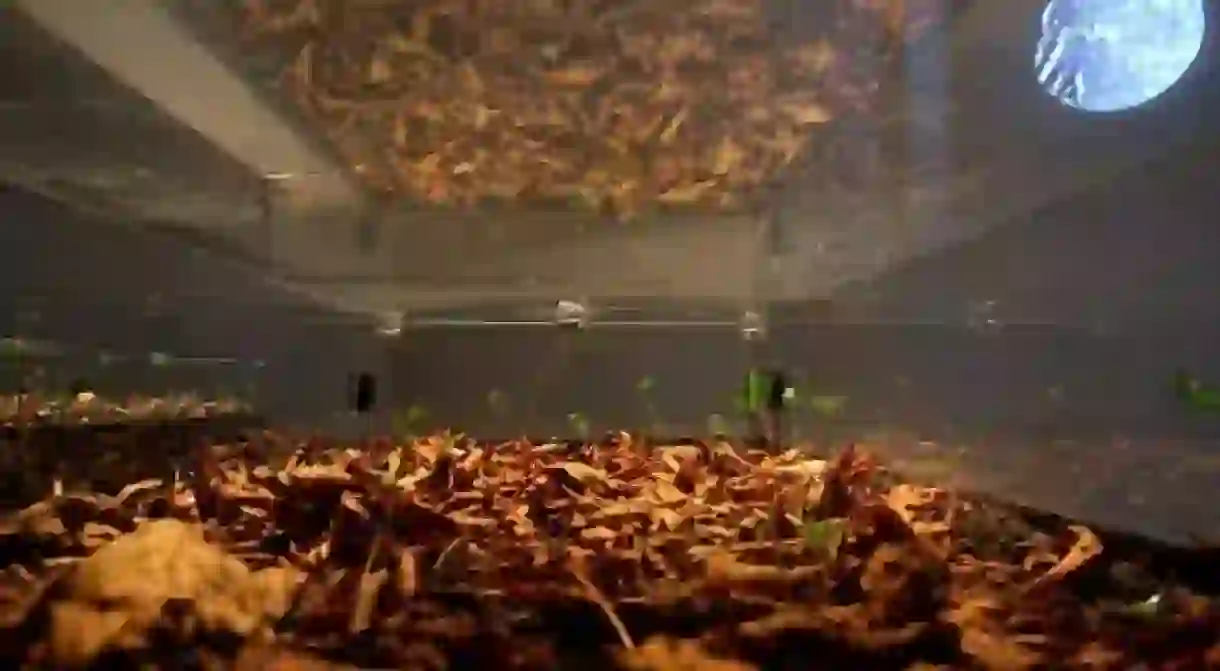Finland’s Down-to-Earth Tragicomedy at the Venice Biennale

A large tree crashing into the Finland Pavilion put a sudden end to Finland’s 2011 Biennale show; this event inspired Nordic artists Antti Laitinen and Terike Haapoja. Sprawled over both the Finnish and the Nordic Pavilions, with two distinct solo shows, Laitinen and Haapoja present Falling Trees, a dynamic exploration of art and nature.

Terike Haapoja, Inhale, Exhale 1, installation, mixed media, 2011. Image courtesy: Sandra Kantanen © Terike Haapoja.
The 54th Biennale was no doubt an adventure for the Finnish Alvar Aalto Pavilion; an unpredictable October storm brought irreparable damage to the exhibition and Finland’s iconic pavilion structure, which Finland’s most prominent architect and designer had shipped over to Giardini in 1956. But leave it to curators Marko Karo, Mika Elo and Harri Laakso, known as Collective Gruppo 111, to turn a catastrophe into a curatorial concept for this year’s Pavilion theme, entitled Falling Trees.

Antti Laitinen’s multi-layered plan for the Finland Pavilion, entitled Forest Square, incorporates videos and photography, performance and installation. Laitinen’s concept centres on transplantation, literally. After felling five birch trees from Finland’s Somerniemi area and removing their roots, Laitinen gathered all of the surface components from a 100 square metre patch of forest. Transferred into a vast industrial space, Laitinen then separated moss from soil, needles from branches, different types of soil using methods as diverse as a vacuum cleaner’s centrifugal power and the chopping of an axe. Reassembling and rearranging the forest’s ground components, in Laitinen’s words, ‘..it is like when you’re putting a puzzle together and can’t find the right pieces, so you force them in place anyway’. This process of transplantation is transformed into a photographic triptych. In addition, five thousand kilograms of birch logs transported from Finland provides the absurd backdrop to an Olives and Stones performance, which will be performed by the art collective Other Spaces on the front lawn of the Finland Pavilion.

Humour, persistence and maximum ambition have been consistent in Laitinen’s work. A self-made Bark Boat, helped him sail the Baltic Sea in 2010; before that, It’s My Island (2007) and Bare Necessities (2002), respectively, saw him build his own island and spend days in the forest without food or clothing. But his so-called absurdity also compels his audience to question the normality of their routines, the society around them and their dearly-held assumptions.
Terike Haapoja, whose work for the Finland National Pavilion will be housed in the Nordic Pavilion, takes a more scientific, human/non-human, activist approach. Haapoja’s project entitled Community (2007-2013) is a strikingly colourful multi-channel video installation at first glance; look more closely, however, and the outlines of a horse, a dog and other animals that have just died morbidly appear. Recorded on infrared video, they fade away before our eyes into the blue background. Haapoja’s exhibition is separated into two parts, one set of installations is called Closed Circuit – Open Duration (part of which is Community), and the second is Party of Others, which explores how humans balance in the grand scheme of nature, united with the environment by their own mortality. According to Haapoja: ‘I wanted to transform the building into a sort of “pavilion of the species” and to challenge the familiar human- and nation-state-centric approach, which is often found at the heart of the exhibitions at the Biennale’.

Like her two-part exhibition at the Biennale, which has evolved from older projects, Haapoja’s works are often the result of a collaborative process that brings together experts from the fields of environmental research and computer programming. ‘A human being should be examined as an ecosystem and a part of nature, not as an individual. We are not beings separate from the rest of the environment, and neither are we the only ones to communicate their needs and keep in contact with each other’, she explains.
Finland has created, both literally and metaphorically, a multidimensional garden of knowledge where one cannot simply grab a fruit that answers all questions. Instead, we are invited to recognise, think, imagine and shake our own foundations, constructing a new creative puzzle that is, above all, open to the world.
Finland team
Theme: Falling Trees.
Artists: Antti Laitinen, Terike Haapoja.
Commissioner: Raija Koli.
Curators: Collective Gruppo 111 (Marko Karo, Mika Elo, Harri Laakso).
Venue: Alvar Aalto Pavilion at Giardini.
About The Culture Trip’s Venice Biennale Project
The 55th International Art Exhibition of the Venice Biennale will take place from 1 June – 24 November. The Culture Trip’s Venice Biennale Series is an article series leading up to the start of the exhibition. With 88 countries participating in this year’s Biennale — 10 of them for the first time — and 150 artists from 37 countries, our coverage over the next couple of months will highlight a selection of the National Pavilions that will be participating in the 2013 edition of the Venice Biennale. Watch this space for our daily Venice Biennale updates or follow us on Twitter, Facebook and Pinterest!
By Danai Molocha

The Culture Trip showcases the best of art, culture and travel for every country in the world. Have a look at our Finland or Europe sections to find out more or become involved.













